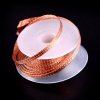Ok, what wattage does the iron say and what make, the 'google' may provide some info if I know the spec.
For what it's worth, wattage is rarely an indication of temperature, wattage is the grunt the iron has, the ability to heat whatever touches it, small wattage irons are good for circuit boards, typically 25W, for OO then 50W is usually good and for O gauge 80W is good.
There are of course many who solder in O with a 25W iron, I have no idea how they do that

that's real magic

A word of caution though, big irons and high temps do have a habit of warping half etch overlays and beading strips, more so in 4 mm scale, but for normal thickness material you should be okay. If you're not sure then use some of that scrap etch around the outside and see how you get on with temps etc.
That's exactly what the carrier etch is for, not to hold you're precious model, but to give you an endless stream of test pieces to play with

Flux, I can see the logic of applying a small amount, but you're inside the tender doing structural work, you really don't need to control where the solder goes. Besides, it'll only go where the heat is, you can flood the whole piece with flux but the solder will only flow out as far as the heat will let it.
Also, being as you're inside, there's no need to be neat, life's too short

, and, I wouldn't of bothered soldering all that you have, you really don't need to. I'd add a seam around the coal space front and sides where it meets the underside of the tank top..... as that will be visible from above.....and no more. If I was really really worried, then a couple of small dabs down the sides and two small dabs on the rear at the outside edges.
Most of your strength is going to come when you solder the tabs to the footplate, and remember, we still have external overlays to go on as well, there's more than enough strength coming further along in the build.
Fibre brush, I'd be surprised if it damaged the metal, maybe a half etched sheet like the tender outer sheets, but the inner core is full thickness and can take quite a beating, again, if you're not sure, go beat up some carrier etch, give it a good old scrub and see if it deforms.
If I ever need to give something a good scrub before assembly, I always do it in the flat before it's folded up and always on a firm surface, very low risk of damage that way.
The carrier etch is your playground, it's the same thickness (unless it's a half etched sheet area, aka tank sides etc) as your model and will behave the same was as your model, bending, forming, soldering, cleaning.














 , and, I wouldn't of bothered soldering all that you have, you really don't need to. I'd add a seam around the coal space front and sides where it meets the underside of the tank top..... as that will be visible from above.....and no more. If I was really really worried, then a couple of small dabs down the sides and two small dabs on the rear at the outside edges.
, and, I wouldn't of bothered soldering all that you have, you really don't need to. I'd add a seam around the coal space front and sides where it meets the underside of the tank top..... as that will be visible from above.....and no more. If I was really really worried, then a couple of small dabs down the sides and two small dabs on the rear at the outside edges.








